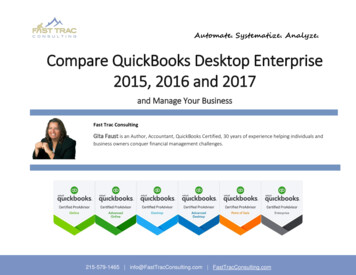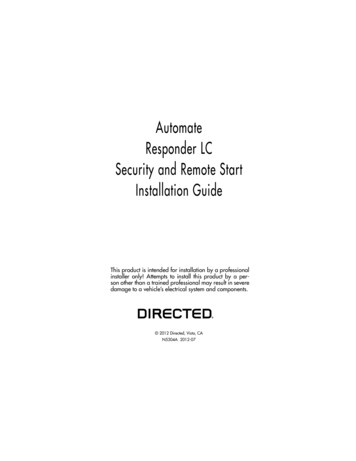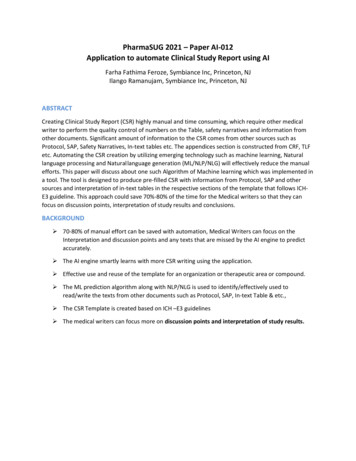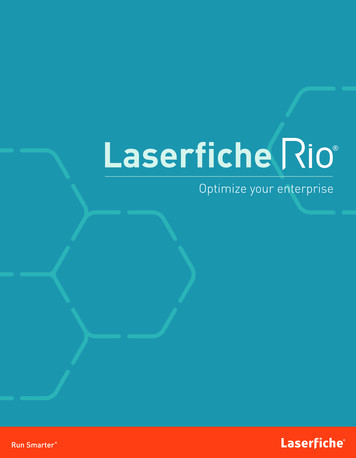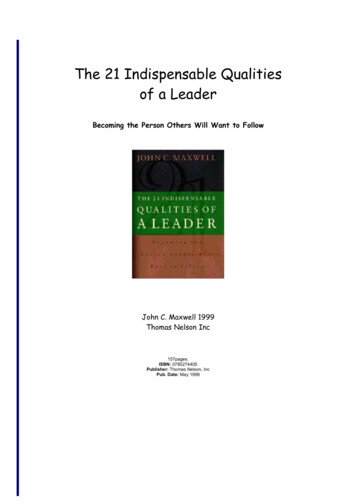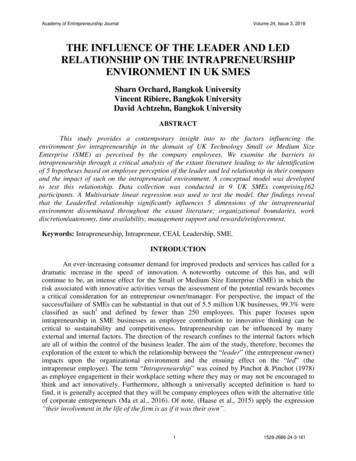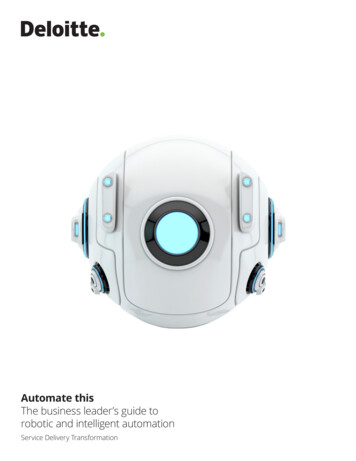
Transcription
Automate thisThe business leader’s guide torobotic and intelligent automationService Delivery Transformation
Proposal title goes here Section title goes here As the nature of work haschanged, so too have themethods of automation.Robotic process andintelligent automation toolscan help businesses improvethe effectiveness of servicesfaster and at a lower cost thancurrent methods, but withimportant limitations.Global Business ServicesOutsourcingShared Services03
Service Delivery Transformation Automate this The business leader’s guide to robotic and intelligent automation ContentsForeword5Process automation: What and why?7Nuts and bolts: Basics of enterprise automationusing robotic process automation11Breaking through the hype: Six myths of roboticprocess automation and intelligent automation15Dip your toe or dive in? Look before you leap18A glimpse of the future22Authors24Endnotes2504
Service Delivery Transformation Automate this The business leader’s guide to robotic and intelligent automation ForewordWe have seen it in the movies.we haveread fantastical futuristic fiction about it asyoungsters in school.and now it is upon us:Robots performing human tasks.The future posed by visionary film creatorsand novelists is still a bit further away, butthe technological advancements whichcould make it possible are coming, andpotentially with great speed. There is abuzz around how robots can transformbusiness processes. We have been talkingfor years about robots—the droids thatmimic humans in a factory—but now we areon the verge of seeing robots that replicatethe human brain, rather than only armsand legs. Just like their physical cousinstransformed manufacturing, these “virtual”robots are likely to change the way we runour business processes.Robot-led automation has the potential tochange today’s workplace as dramaticallyas the machines of the Industrial Revolutionchanged the factory floor. Core skills that arerelated to business—process knowledge,technology integration, and insightfulanalytics—could be delivered througha leveraged model at a lower cost. Thecapability and demand already exist for thistechnology, and it is enabled by abundantcomputing power and software solutionsthat can be packaged and downloadedas “apps.”So why do we need robots to run businessprocesses in the first place? Well, to beginwith many of our business processes are notas intelligent as they could be. Some of themcut across many IT systems that do notalways talk to each other. Others are just tootime consuming for humans to perform. Torun them smarter is however an expensiveproposition. It often involves a massiveIT transformation such as an EnterpriseResource Planning (ERP) implementationor a toolset such as a business processmanagement system (BPMS). Otherbusiness processes rely on insights basedon human reasoning that computers havenot been able to replicate.Therefore, today’s business conditions areripe for major change and the emergingtechnologies within the robot-ledautomation realm could just be the solution.But the hype about these solutions takingover the workplace obscures the reality,and can confuse the casual observer.There are actually two separate genres ofautomation tools emerging, both of whichhave the potential to make our processessmarter and more efficient, in very differentways. The first is a set of tools classified as“Robotic Process Automation (RPA),” whichhas been maturing quietly over the lastdecade, to the point where they are nowused for enterprise-scale deployments, veryquickly and at very low cost. The secondgenre is “Intelligent Automation (IA)”—toolsenabled by cognitive technologies,1 nascent,but with hugely transformative potential inthe near future. We liken the current state ofthe RPA and IA landscape to the transitionalyears of ERP tools. Remember various ERPs,before the graphical user interface and thewonders of the data warehouse? Robotictools are in a similar state today. Just ascapabilities of the ERP tools exploded assuccessive releases leapfrogged each otherand customer support offerings becomeincreasingly user friendly, we see similarcapability trends in the robotic space.Alright, but what exactly are these robotled automation tools and how similar ordifferent are RPA and IA from each other?When should we use either of them, andhow is the supply side geared to startsolving our problems?Given such interest on the demand side,the ongoing maturation of available tools,and the promise of new ways of working insupport of a world class, advanced serviceeconomy, this is a good time to provide acomprehensive report on this emergingspace. We combined efforts to research thisarea in depth. To better understand the RPAspace and market capabilities, we reachedout to a number of suppliers with anextensive data request coupled with furtherdiscussions and technology demonstrationswith some of those suppliers.** In some sections of this paper, we have used some products and vendors as examples to better illustrate a concept. The intent of these references is limited to theillustration of concepts, and is not meant to compare product capabilities or to recommend any particular solutions.05
Service Delivery Transformation Automate this The business leader’s guide to robotic and intelligent automation We also drew upon our experience,knowledge base, and tools in theareas of technology-enabled businesstransformation, shared services, andoutsourcing. And finally, we spoke to endusers and had a number of contextualconversations with experts in ournetwork. It’s important to note thatwhile we had thorough discussions withsuppliers regarding their claims of productcapabilities, we did not independentlyvalidate their representations nor did weconduct formal reference checks or makeany attempt to confirm the fitness forany purpose.We have enjoyed this process as we jointlydiscovered the breadth, depth, and nuancesof this space—and are delighted to bringthis knowledge and perspective to the largerbusiness reader base.Peter LowesPrincipalBusiness Model TransformationDeloitte Consulting LLPFrank CannataSenior Vice PresidentOperations and Planning SolutionsWarner Bros. Entertainment Inc.06
Service Delivery Transformation Automate this The business leader’s guide to robotic and intelligent automation Process automation:What and why?Different means to the same endProcess automation is nothing new—organizations have always looked for waysto achieve greater operating efficienciesand support growth. Process automationat scale arguably began more than twocenturies ago in the textiles industry,when factory machines began to be usedfor labor-intensive tasks such as weaving,stitching, and spinning cotton. Physical tasksof this nature are now widely automatedacross manufacturing and other industries,and developments in the field of roboticcontinue to lower the cost of automationwhile expanding the capabilities.As the nature of work has changed, so toohas the method of automation. For theinternal operations of a modern business,the chief enabler of automation has beentraditional information technology (IT). Manyorganizations have applied technology tobusiness processes through the use of ERPand other business applications. However,some of those same organizations still havea patchwork of less-than-optimal businessprocesses and applications that do not talkto each other and rarely ease the workloadof generating meaningful insights—which translates into increased costs,unnecessarily high-cycle times, inconsistentquality, and impaired agility.One possible explanation for thispredicament is growth—few companiesmanage business growth systematically.Even organic growth often results07in expedient solutions to problems,inadequate attention to scalability ofprocesses and technologies, and ‘siloed’applications. Inorganic growth typicallypresents an even larger problem—bringingtwo disjointed organizations together andcombining multiple sets of operations isdifficult to achieve.To date, organizations have responded tothese challenges in various ways, including: By investing in newer or betterintegrated enterprise applications. Onpaper, this typically represents the “right”approach, but such projects are expensiveand many implementations fail. Even theprojects that prove to be successful maytake years to implement—and any effort toshorten the project time can compromisethe chances of success and increase therisk of failure. Running costs may stillbe high after completion, and the longdeployment times can limit agility. By optimizing processes with the aidof a BPMS—a software application thatsupports the process improvement lifecycle, and often facilitates integrationbetween enterprise applications toincrease the amount of “straight-throughprocessing” possible within a process.Effectively, this is a similar approach to thatof an IT transformation, but with a smallerscope than ERP. They are generally lesscostly and lower risk to deliver, but mayalso offer reduced benefits. By developing shared services and/or outsourcing processes to a thirdparty Business Process Outsourcingprovider (BPO), who will typically deriveefficiencies through labor arbitrage andby virtue of scale. This is often a onetime labor arbitrage benefit, and manyorganizations have already realized theseefficiencies, effectively hitting a ‘ceiling’beyond which cost and performance canbe further improved only through doingthings differently.Each of these options has its limitations. Inthe ongoing quest for operational efficiency,business leaders may keep asking howthey can: Avoid or defer the high investment of largetechnology transformation programs whileachieving their operating objectives. Support business growth without theproportional increase in operating costs. Derive greater value from alreadyoutsourced operations. Support product, process, and businessmodel innovation, and test ideas withoutcostly new technology.Process automation presents a means toachieving these aims, and there are twogenres of tools in particular that businessesshould be aware of: RPA and IA.
Service Delivery Transformation Automate this The business leader’s guide to robotic and intelligent automation RPA: Bringing automation benefits tosmall-scale processesRPA tools can help businesses improve theefficiency of processes and the effectivenessof services. Classic process candidatesthat can benefit from RPA typically haverepeatable and predictable interactionswith IT applications including those thatmay require toggling between multipleapplications (swivel chair). Rather thanrequiring fundamental process redesignassociated with IT-driven transformation,RPA software “robots” are able to performsuch routine business processes bymimicking the way that people interactwith applications through a user interfaceand also by following simple rules tomake decisions. An example of a routinebusiness process would be the retrieval ofinformation from one system and enteringthe same information into another systemor activating another system function.RPA tools evolved quietly over the lastdecade, but have now reached a levelof maturity where process automationis possible at a significant scale. Entireend-to-end processes can be performedby software robots with very little humaninteraction, typically to manage exceptions.RPA software robots are not necessarilyrelevant to only a particular businessFigure 1: RPA compared to traditional process transformation approachesLow3.OutsourcingMediumHighProcess disruption4. RPA1. ITTransformationLow2. BPMSMediumHighfunction or industry: any methodical,standardized, repetitive process that followsconsistent rules and is wholly executedthrough a human-machine interaction islikely to be a good candidate.With a license for a software robot likely tocost less than an onshore staff member oran offshore staff member, the commercialattractiveness of this approach is selfevident. There are nonfinancial benefitstoo, as robot-based process performanceis designed to be more predictable,consistent, and less prone to errors ascompared to a human process. Moreover, arobot workforce can typically be deployedin a matter of weeks. Once in place, newprocesses can often be assigned to themin days if not hours. Thus, RPA solutionsgenerally have lower implementationcost, require shorter implementationtime, and carry lower risk than large ITtransformations. However, it is importantto find the right processes and applyRPA judiciously.In most organizations, there are manyroutine processes performed manuallythat lack the scale or value to warrantautomation via IT transformation, but forwhich macros and other such desktopautomation tools are too limited toeffectively address. RPA can help addressthis gap, reducing the ‘minimum viable scale’of process automation compared to othertraditional options. See Figure 1.Speed and predictability of executionSource: Deloitte AnalysisAs used in this document, “Deloitte” means Deloitte LLP and its subsidiaries. Please see www.deloitte.com/us/about for a detailed description of the legalstructure of Deloitte LLP and its subsidiaries. Certain services may not be available to attest clients under the rules and regulations of public accounting.08
Service Delivery Transformation Automate this The business leader’s guide to robotic and intelligent automation Organizations using RPA solutions typicallyexperience benefits beyond cost reduction: Decreased cycle times and improvedthroughput: Software robots aredesigned to perform tasks faster than aperson can and do not require sleep—making 24x7 operations possible. Flexibility and scalability: Once aprocess has been defined as a seriesof instructions that a software robotcan execute, it can be scheduled fora particular time, and as many robotsas required can be quickly deployed toperform it. Equally, robots can be quicklyreassigned when other, more importantprocesses arise—as each r
increasingly user friendly, we see similar capability trends in the robotic space. Alright, but what exactly are these robot-led automation tools and how similar or different are RPA and IA from each other? When should we use either of them, and how is the supply side geared to start solving our problems? Given such interest on the demand side, the ongoing maturation of available tools, and .

